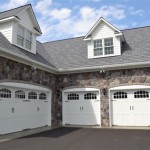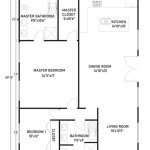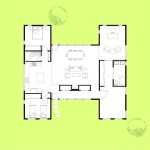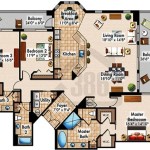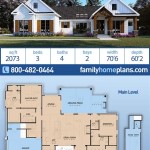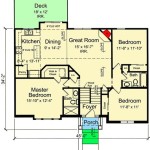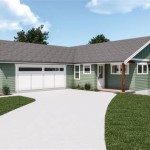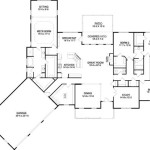A Frame House Floor Plans: A Comprehensive Guide
A-frame houses, characterized by their distinctive triangular shape, offer a unique blend of architectural appeal and practical functionality. This architectural style, popularized in the mid-20th century, continues to resonate with homeowners seeking a modern, rustic, or vacation-oriented dwelling. The defining feature of an A-frame house is its steeply angled roof that extends to or near the ground, forming the letter "A." These structures often utilize open floor plans to maximize space and capitalize on the dramatic ceiling heights. Understanding the nuances of A-frame house floor plans is crucial for anyone considering building or renovating such a structure.
This article explores the key concepts and considerations involved in designing effective and efficient A-frame house floor plans. It delves into the common design challenges, potential solutions, and the various factors influencing the layout of interior spaces within this architectural form.
Understanding the Core Design Principles of A-Frame Floor Plans
The design of an A-frame house floor plan is inherently dictated by the structure's shape. The angled walls create limitations in usable floor space, particularly on the upper levels. Optimizing the layout requires a careful balance between maximizing space, ensuring functionality, and maintaining the aesthetic appeal of the interior environment. The foundational design principles revolve around adapting to the constraints and leveraging the inherent advantages of the A-frame structure.
One crucial principle is verticality. A-frame houses naturally lend themselves to soaring ceilings and open, multi-level spaces. Utilizing the vertical dimension effectively can significantly enhance the perceived spaciousness and create a sense of grandeur. Incorporating lofts, mezzanines, or split-level designs allows for the creation of distinct yet interconnected zones within the house.
Another important principle is natural light optimization. Due to the roof’s substantial surface area, windows are often strategically placed to maximize daylight penetration. Large windows, skylights, and clerestory windows are common features in A-frame homes, bringing light into the interior while also offering panoramic views of the surrounding landscape. The placement and size of windows must be carefully considered to balance light intake with energy efficiency and privacy concerns.
Finally, spatial efficiency is paramount. The sloped walls can create awkward or unusable spaces, particularly near the floor. Designing built-in storage solutions, such as cabinets and shelving that conform to the angle of the walls, can effectively utilize these areas. Multi-functional furniture and flexible layouts also contribute to making the most of the available space.
Common Challenges in A-Frame House Floor Plan Design
Designing an A-frame house floor plan presents several unique challenges. These challenges stem primarily from the limited wall space, the steep angles of the roof, and the implications for furniture placement and circulation patterns within the home.
One of the most significant challenges is effectively utilizing the space on the upper floors. The sloping walls drastically reduce headroom, making it difficult to accommodate standard furniture and navigate comfortably. This limitation often necessitates creative design solutions, such as custom-built furniture or the use of low-profile pieces. Attic spaces, if present, can be challenging to access and utilize effectively due to their limited height and irregular shape.
Another challenge lies in the placement of essential fixtures and appliances, particularly in kitchens and bathrooms. Standard kitchen cabinets and countertops may not fit neatly against the angled walls, requiring custom solutions or unconventional layouts. Similarly, incorporating standard bathroom fixtures, such as showers and bathtubs, can be difficult given the limited vertical space. Creative plumbing solutions and strategic placement are often necessary to ensure functionality and compliance with building codes.
Furthermore, heating and cooling an A-frame house can pose challenges. The large surface area of the roof can lead to significant heat loss in the winter and heat gain in the summer. Proper insulation is crucial for maintaining comfortable indoor temperatures and minimizing energy consumption. The open floor plans common in A-frame houses also present challenges for temperature regulation, as heat can easily escape to the upper levels.
Accessibility can be another concern, particularly for individuals with mobility issues. The steep stairs required to access the upper floors may not be suitable for everyone. Incorporating ramps or elevators can improve accessibility, but these additions may compromise the aesthetic appeal of the A-frame design.
Finally, sound transmission can be an issue in A-frame houses due to the open floor plans and the lack of soundproofing inherent in the structural design. Sound can easily travel between different levels of the house, potentially disrupting privacy and creating noise pollution. Implementing soundproofing measures, such as adding insulation to walls and floors, can mitigate this problem.
Key Considerations for Optimizing A-Frame House Floor Plans
Optimizing an A-frame house floor plan requires careful consideration of several key factors. These considerations include lifestyle, functionality, budget, and aesthetic preferences. By carefully weighing these factors, it is possible to create a floor plan that meets the needs of the occupants while also preserving the unique character of the A-frame design.
The first consideration is lifestyle. How will the house be used? Is it a primary residence, a vacation home, or a rental property? The intended use of the house will significantly influence the design of the floor plan. For example, a vacation home may prioritize open communal spaces for gatherings, while a primary residence may require more private areas for sleeping and working. The number of occupants, their ages, and their lifestyles should all be considered when developing the floor plan.
Functionality is another critical consideration. The floor plan should be designed to accommodate the daily activities of the occupants in a convenient and efficient manner. The layout should prioritize the flow of movement between different areas of the house. Kitchens and bathrooms should be designed with functionality in mind, incorporating ample storage and ensuring adequate workspace. Bedrooms should be located in quiet areas of the house, away from noise and distractions. The floor plan should also provide adequate storage space for belongings, tools, and equipment.
Budget is a significant constraint in any construction or renovation project. The cost of building or renovating an A-frame house can vary considerably depending on the size, materials, and complexity of the design. Custom-built features, such as cabinets and furniture, can add to the overall cost. It is important to develop a realistic budget and prioritize the most essential features. Value engineering, which involves finding cost-effective alternatives without compromising quality, can help to stay within budget.
Aesthetic preferences play a crucial role in shaping the design of an A-frame house. The interior should reflect the personal style of the occupants. The choice of materials, colors, and finishes can significantly impact the overall look and feel of the house. A-frame houses often lend themselves to rustic or modern designs, but other styles can also be successfully incorporated. The exterior of the house should also be carefully considered, ensuring that it integrates seamlessly with the surrounding landscape.
In addition to these core considerations, sustainability is increasingly important. Incorporating energy-efficient features, such as solar panels, high-performance windows, and efficient heating and cooling systems, can reduce the environmental impact of the house and lower operating costs. Using sustainable materials, such as reclaimed wood or recycled content, can further enhance the environmental friendliness of the design.
Finally, local building codes and regulations must be adhered to. These codes may dictate specific requirements for structural integrity, fire safety, accessibility, and energy efficiency. Consulting with a qualified architect or building contractor can help to ensure compliance with these codes.
By carefully considering these key factors, it is possible to create an A-frame house floor plan that is both functional and aesthetically pleasing. The design process should be iterative, involving continuous refinement and adjustment based on feedback and new information. With careful planning and execution, an A-frame house can become a comfortable and stylish home that reflects the unique character of its occupants.

A Frame Cottage Plans For Guest House Temp Cabin Plan

Prefab Small Homes On Instagram A Frame House Plan No 86950 By Familyhomeplans Com Total Living Area 1272 Sq Ft 3 Bedrooms And 1 5 Bathrooms Interior Plans

A Frame House Plans Floor Cool

Modern A Frame House Floor Plans

A Frame House Plans Floor Cool

A Frame Floor Plan 1 Bedrm Bath 908 Sq Ft 146 1841

Classic Design For A Low Budget Frame Project Small House Plans Cabin

A Frame House Plans Everything You Need To Know Field Mag

A Frame Tiny House Plans Cute Cottages Container Homes Craft Mart

A Frame Style Plans Vacation Type House

